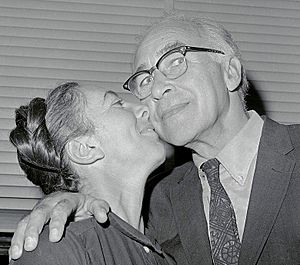George Wald facts for kids
Quick facts for kids
George Wald
|
|
|---|---|

George Wald in 1987
|
|
| Born |
George Wald
November 18, 1906 |
| Died | April 12, 1997 (aged 90) Cambridge, Massachusetts, U.S.
|
| Alma mater | New York University Columbia University |
| Known for | Pigments in the retina |
| Spouse(s) | Frances Kingsley (m. 1931; div. ?) (1906-1980) (1924-2016) |
| Children | 4 |
| Awards | Eli Lilly Award in Biological Chemistry (1939) Albert Lasker Award for Basic Medical Research (1953) Nobel Prize in Physiology or Medicine (1967) |
| Scientific career | |
| Fields | Neurobiology |
| Institutions | Harvard University |
George Wald (born November 18, 1906 – died April 12, 1997) was an American scientist. He is famous for his work on how our eyes see color and light. He studied the special colored chemicals, called pigments, found in the retina (the back part of your eye). In 1967, he won the Nobel Prize in Physiology or Medicine for his important discoveries about vision. He shared this award with two other scientists, Haldan Keffer Hartline and Ragnar Granit.
Wald also spoke out about big world problems. In 1970, he warned that people needed to act quickly to solve issues facing humanity.
How We See: George Wald's Research
As a young researcher, George Wald made an exciting discovery. He found that vitamin A is a key part of the retina in our eyes. The retina is the light-sensitive layer at the back of your eye.
He did more experiments and learned something amazing about a pigment called rhodopsin. Rhodopsin is a special chemical found in the rod cells of your eye. These cells help you see in dim light. Wald found that when light hits rhodopsin, it breaks down into a protein called opsin and a compound that contains vitamin A. This showed that vitamin A is super important for your eyes to work properly.
In the 1950s, Wald and his team worked to take out these pigments from the retina. They used a tool called a spectrophotometer. This machine helped them measure how much light the pigments absorbed. Different pigments absorb different wavelengths (colors) of light. By doing this, they could figure out which colors of light our eyes see best.
Since rod cells are very common in the retina, their first measurements mainly showed how rhodopsin works. Later, Wald used a new method called microspectrophotometry. This allowed him to measure the light absorption directly from single cells. This was a big step! It helped him discover how the pigments in cone cells work. Cone cells are responsible for seeing color and bright light.
George Wald's Life Story

George Wald was born in New York City on November 18, 1906. His parents, Ernestine and Isaac Wald, were Jewish immigrants. He went to Brooklyn Technical High School and was part of its first graduating class in 1923.
He earned his first degree from New York University in 1927. Then, he got his PhD in zoology (the study of animals) from Columbia University in 1932. After finishing his studies, he received a special grant to travel and work with other scientists.
Wald traveled to Germany and worked with Otto Heinrich Warburg. There, he made his important discovery about vitamin A in the retina. He then went to Zurich, Switzerland, to work with Paul Karrer, who had discovered vitamin A. Wald also worked briefly in Heidelberg, Germany. However, he left Europe for the University of Chicago in 1933. This was because Adolf Hitler came to power, and life became very dangerous for Jewish people in Europe.
In 1934, Wald joined Harvard University. He started as an instructor and later became a full professor.
George Wald was recognized for his scientific work. He was elected to the American Academy of Arts and Sciences in 1948. He also became a member of the National Academy of Sciences in 1950 and the American Philosophical Society in 1958. In 1967, he received the Nobel Prize for Physiology or Medicine for his amazing discoveries about how we see. He also won other awards, like the Frederic Ives Medal in 1966 and the Paul Karrer Gold Medal in 1967.
Beyond science, Wald cared deeply about the world. He often spoke out on important social issues. His fame as a Nobel winner helped bring attention to his ideas. He was a pacifist, meaning he believed in peace and was against war. He strongly opposed the Vietnam War and the nuclear arms race (the building of many nuclear weapons).
In 1980, Wald was part of a group that visited Iran during the Iran hostage crisis. This was a time when American citizens were held hostage there. In 1986, he was invited to Moscow to advise Mikhail Gorbachev, the leader of the Soviet Union, on environmental questions. While there, Wald bravely asked Gorbachev about the arrest of Yelena Bonner and her husband, Andrei Sakharov, who was also a Nobel Prize winner. Wald reported that Gorbachev said he didn't know about it. Soon after, Bonner and Sakharov were released in December 1986.
George Wald passed away in Cambridge, Massachusetts. He was married twice. He had two sons, Michael and David, with his first wife, Frances Kingsley. With his second wife, biochemist Ruth Hubbard, he had a son, Elijah, and a daughter, Deborah.
See also
 In Spanish: George Wald para niños
In Spanish: George Wald para niños
- List of Jewish Nobel laureates
- Retinal


